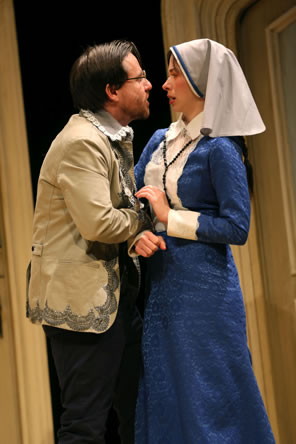A Conversation with the Founders of Fiasco Theater
[Return to previous page]
So let's talk about how you all came together. What's your personal/professional history as a group?
BEN: Shall I take that, guys?
JESSIE and NOAH: Sure.
BEN: We started because of the work that we'd done together in grad school which, in the case of Noah and Jessie and me, includes directing short plays of each others'. I directed a short play of Noah's. Noah directed Jessie and me in a Harold Pinter play. Noah and I did a summer Shakespeare tour as actors together, along with many other experiences that we had together in school. So we had gotten to try on all kinds of different identities theatrically, not just as actors but as makers of theater, as teachers—Noah and I started teaching right after grad school. So we were not only interested in making theater but in talking about making theater.
Those kind of twin impulses of performing and teaching or of making the work and thinking about the work really informed our desire to start putting a lot of our ideas and questions into practice, which we did through the teaching and then through a workshop, actually, of The Two Gentlemen of Verona back in 2007. We were working but not a lot, and we decided that we really wanted to sort of test what it would be like to do a real show with these principles leading the way, which was something that meant a lot to us but that seemed to be kind of missing from the New York conversation about classical theater and about making new work. So that was how we started.
Where does Twelfth Night come in, by the way?
JESSIE: We did Twelfth Night in 2010. Basically, we'd done a workshop of Two Gentlemen of Verona, we'd done some teaching. Ben did a workshop of Twelfth Night with some of our students in 2008 when Noah and I were both working out of town, and then we decided to do an Off Off [Broadway] production of Twelfth Night after Cymbeline. We did Cymbeline Off Off Broadway as our first show, then it got picked up for an Off Broadway run. Between the Off Off production at Access Theater and the Off Broadway run at Theater for a New Audience [of Cymbeline], we produced Twelfth Night, also at Access Theater. And that was with a cast of eight.
Did the success of Cymbeline take you by surprise?
BEN: Yes.
JESSIE: Yeah, absolutely.
NOAH: Absolutely. We did Cymbeline because, you know, we were having professional experiences and getting work, but not to the extent we wanted, and those experiences weren't always as interesting or as fruitful or artistically generative for us as those that we had at graduate school. We were craving that experience, so we decided to put a project together for ourselves, something we were passionate about, and we would kind of joke that it didn't matter what happened because nobody was going to come see it anyway. The producing plan was that we were hoping to get 22 people a night to come see it just to cover the cost, as we were putting every penny in. And we thought, "Well 11 performances, that's like three times more people than we know, how will we ever get that many people to come see the show?"

Angelo (Paul Coffey) accosts Isabella (Emily Young) in Fiasco's Measure for Measure. Young also played Mistress Overdone, and Coffey played Elbow. Photo by Joan Marcus, New Victory Theater.
I think it's important because, not that we didn't want people to see it, but we weren't doing it for any other purpose other than it was the thing we wanted to do artistically and a work we believed in. We weren't trying to get agents, we weren't trying to create something that would get picked up. We were risking for ourselves in order to have an experience. I think that's the thing, the energy and generosity of spirit at the center of it, that is what so many of our audience members have enjoyed about it.
So, it came as a huge surprise to us. Even that anyone from The Times would review it, and the scale of response to it was thrilling and astonishing.
And as you know it sort of has defined us for a long time. We've been riding the arc of that little comet in a wonderful way. Now we're doing other things like Into the Woods and other shows that are expanding what I think Fiasco's identity is, but it still remains one of the most magnificent Cinderella stories. It actually happened that someone came and saw our show and said, "I'm going to put you in my season, kid." Really, really remarkable.
You had the very famous trunk in Cymbeline. You had the doors in Measure for Measure. Where do you guys come up with these sets, and is it you that comes up with the set ideas or is it a set designer that comes up with it?
[Ben and Noah respond at the same time, both say, "Go ahead" to the other, and both again trample over each other trying to answer. They laugh.]
BEN: This is turning into an Abbott and Costello thing. I'll just jump in here because I'll have to hop off in a second. We come up with those ideas. What we do is we tend to ask ourselves what are the things that we absolutely need to have to tell the story and then we try to basically give ourselves only that much stuff and let our imagination and the audience's imagination and music and physicality and creativity fill in the rest.
So, we don't want to clutter either the stage or the audience's access to the play. We want them to see actors doing things and keep the visual metaphors as simple as we can, and to reuse the things that we put on stage as many different ways as we can. That's why we anchor ourselves around those visual ideas, because they help us behave on stage, but they leave enough to the imagination that we're not filling in all the gaps.
But we come up with those ideas, and in the case of Cymbeline we worked with our friend Jacques Roy, who built the trunk. And in the case of Measure for Measure, we worked with the Tony-winning set designer Derek McLane who executed and made beautiful our ideas with the doors. So it's our ideas, and the designer helps us to make those ideas turn into something that's actually a thing.
What are we going to expect for Two Gents?
JESSIE: Well, the other thing I was going to add to that which is a bridge to Two Gents is that it's very important to us that we are doing the play in the room that we are in with the audience, and that we're all in the same space, we're breathing the same air, we're hearing the music together. We're not trying to pretend that the audience is not in the same room that we are. In the beginning, that informed what we ended up doing with Cymbeline, because we did it in a big loft space where there was no backstage, there was no way to do a blackout. So, knowing that, we embraced the idea that we should just all be on all the time, and that's part of the rough magic that's at the center of that show, which lines up with its content.
We knew we were going to do Measure for Measure at the New Victory, and the space is beautiful. The doors were our way in thematically, and our designers integrated them into the existing architecture of the New Vic beautifully.
And so with The Folger, it's the first time that we're working in a space that has such a strong identity and such a Shakespearean identity. Thus far, the first question we tend to ask ourselves is what do we absolutely have to have and only have to tell this story. And you don't need anything for Two Gents. You need people. It's about relationships. It's about pairs of relationships and one's relationship to oneself and finding yourself in others. So, right now, we're not planning to have much at all, except ourselves and this beautiful Shakespearean theater that looks a lot like where this play may have first been performed. And perhaps a lot of letters, because letters are pretty big in the plot, and the written word and putting love into language is at the center of the play. So we may expand on that and use paper in various ways. But right now, it's us and a lot of letters.
NOAH: What was important about the trunk and the doors is they are both engendered by the text. They are contained within the plot of the play, they actually come from the thematic content, they all resonate in themselves, but they also allow the behavior to happen on stage between human beings. So, they aren't visual metaphors imposed upon a set that the actors can't interact with in ways other than human beings interacting with those actual things, like a trunk or like a door. Now, we may use them in other ways that are representative, but we're still behaving with them as human beings. So, it's important to us that the object that adds to the physical life of the play is a thing that people use and behave with as human beings as opposed to a giant metaphor descending from the heavens and just sort of sits there visually but otherwise it doesn't make a difference to the acting.
[To continue the interview, click here] [For a PDF of this interview, click here]



 Find additional Shakespeareances
Find additional Shakespeareances